
~~~~~~~~~~~~~~~~~~~~~~~~~~~~~~~~~~~~~~~~~~~
Live Earth Farm (Com)Post
21st Harvest Week, Season 12
August 20th - 26th, 2007
~~~~~~~~~~~~~~~~~~~~~~~~~~~~~~~~~~~~~~~~~~~
(Paper
version of this newsletter has been discontinued. See below.)
In this issue
--Greetings from Farmer Tom
--Alan Chadwick/Chez Panisse errata
--Farm Work Days update
--End of an era: Paper Newsletters to be discontinued
--Pictures around the farm
--What's in the box this week
--Notes from Debbie's Kitchen
--Calendar
--Contact Information
"spring blossoms fall leaves rejoice"
~ a five word poem by A. Richard Palmer
Greetings from Farmer Tom
~~~~~~~~~~~~~~~~~~~~~~~~~~~~~~~~~~~~~~~~~~~~~~~~
Debbie always encourages me to write about what's going on in the field: the on-the-ground reality, the changes, mishaps, and maybe most importantly what's growing and what to expect in the next few weeks and months ahead. I, on the other hand, like to reflect on events and ideas which, inspired by the realities of farming, relate to the world around me and the magical and subtler realms within. The attempt, as always, is to balance both sides.
With the first part of the pear harvest behind us and safely stored in the cooler, I like to imagine that we have reached the peak of the season. Not that the workload is any less, but it's definitely one of the seasonal milestones where we allow ourselves to look back for a moment and feel like we've turned the corner, where the beginning of the season is now out of sight and the end, although still far off, has been sighted like a ship appearing on the horizon.
Practically speaking, the farm is in transition getting ready for the fall. The last planting of green beans was sown on Saturday, which should yield by early November. For now, the greens such as kale and chard are plowed back into the soil, and although a new planting of them is scheduled this week, don't expect to see them again in your share for the next 4 to 5 weeks. We have also just sown a new patch of beets, which means they won’t appear again for at least 6 to 7 weeks... for some this is probably a relief!! Carrots are still too small to harvest, so I’m giving them a couple of weeks to size up. We'll have plenty of broccoli and broccolini for a while, and soon more Chinese cabbage and cauliflower.
We've also been busy in the fields plowing and preparing the soil for the fall and winter crops. To improve drainage in anticipation of higher rainfall during the winter season, we are tilling the land more deeply by pulling long (almost 2 feet deep) shanks through the soil. We add most of our annual allotment of compost, gypsum and rock dust to the field at this time of year, and before listing the soil into rows, the field is carefully graded for optimal drainage. After pushing the soil up with large listing shovels, the beds are shaped and made ready for planting. Meanwhile, in the greenhouse Bernadette and Antonia have been busy sowing the next wave of fall and early winter crops, which in turn will keep us busy planting throughout the month of September.
It is a tricky time of year to plan ahead; the last thing on one's mind are the shorter and darker days to come, especially now when we're enjoying the warmest and sunniest days of the year. I am not ready to welcome fall just yet, not as long as I can enjoy the wonderful tomatoes we have right now. The essence of summer for me is captured in a ripe, juicy tomato. Every time I slice into one of the Heirloom tomatoes – whether it's a red Brandywine or the yellow-red Old German (also known as Pineapple Tomato) – I feel like I am holding a beautiful piece of art.
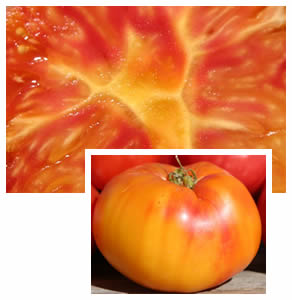 There is a difference between that tomato and a painting
hanging on a wall though; in that the tomato is alive and engages all my senses.
I can gently hold it in my hands and feel the smooth delicate skin covering the
soft flesh; instinctively I bring it to my nose to smell. When I slice it open,
I cut straight through the middle so I can admire the brilliant colors, patterns
and fresh juicy texture. A sprinkle of salt and my mouth starts watering with
anticipation... the first bite is an explosion of flavor. I love to cook with
tomatoes: every dish I make right now is adapted to include them, either fresh,
slightly cooked, or as a sauce.
There is a difference between that tomato and a painting
hanging on a wall though; in that the tomato is alive and engages all my senses.
I can gently hold it in my hands and feel the smooth delicate skin covering the
soft flesh; instinctively I bring it to my nose to smell. When I slice it open,
I cut straight through the middle so I can admire the brilliant colors, patterns
and fresh juicy texture. A sprinkle of salt and my mouth starts watering with
anticipation... the first bite is an explosion of flavor. I love to cook with
tomatoes: every dish I make right now is adapted to include them, either fresh,
slightly cooked, or as a sauce.Maybe, as some suggest, it wasn't the innocent apple that seduced Adam but instead a juicy, drippy, red tomato. This may explain why only fairly recently the tomato has staged a comeback. The tomato, together with Adam and Eve, were cast out to the farthest stretches of the earth, away from the cradle of humanity, somewhere in the deep and impenetrable jungles of Central and South America. Not until the Spanish conquistadors discovered it in the 1500's did it make its way back to Europe, Africa and the Middle East. Once back in Europe, the suspicious Church Fathers immediately "tasted" trouble, condemned the tomato as a scandalous and sinful indulgence, and immediately banned it. On the other hand, the French admired its sensuous appearance and were enticed by it, believing that the red fruit had aphrodisiac powers, and called it 'pomme d'amour' or love apple. Not until the 1800s did the tomato finally gain broad culinary acceptance in Europe. Today, we probably couldn't imagine anything more scandalous than not having tomatoes as part of our diet. So while we are in the thick of them, do enjoy those tomatoes... as well as the rest of your summer indulgences.
- Tom
<back to top>
Alan Chadwick/Chez Panisse errata
~~~~~~~~~~~~~~~~~~~~~~~~~~~~~~~~~~~~~~~~~~~~~~~~
Hi all, it’s Debbie. Just wanted to clarify a slightly mis-worded bit from
Tom’s story about Alan Chadwick and the UCSC Farm and Garden from a couple
weeks ago [Week
18 newsletter]. When I was editing what Tom wrote, I misinterpreted
what I thought he was trying to say, and so wanted to set the record straight.
The sentence I created: “Even
restaurants such as Chez Panisse, famous for it’s embracing of sustainable
food and agriculture principles, was inspired originally by Chadwick” is
not correct. I.e. it’s not that Alice Waters herself got her inspiration
from Chadwick then went on to start her restaurant. What Tom was trying to say
was that some of the alumni of that UCSC program went on to work at famous places,
such as Chez Panisse.
<back to top>
Farm Work Days Update
~~~~~~~~~~~~~~~~~~~~~~~~~~~~~~~~~~~~~~~~~~~~~~~~
Given that we never got enough interest in participating
to actually hold one (we got one or two calls, but we needed
5 to 20 people to make it work), we will be shelving the idea of holding monthly
Work Days. Instead, we are planning a single farm workday scheduled
this fall [date to be announced] to install a few new hedgerows on the farm.
We want to plant the vegetation late enough in the season that they’ll
benefit from the winter rains. We’ll
talk about this in greater detail in a future newsletter. So if you're still
interested in working the farm, stay tuned!
<back to top>
End of an era: Paper Newsletters to be discontinued
~~~~~~~~~~~~~~~~~~~~~~~~~~~~~~~~~~~~~~~~~~~~~~~~
It once was a staple of our CSA; our paper newsletter was our
only method for communicating weekly with our members. But times have changed,
and so must we. Due to the huge popularity of our electronic newsletter, less
than 10% of our membership requested to get the paper version this
year. On top of that, 20% of even that small quantity of paper newsletters has
consistently come back from delivery each week, un-picked up. So... in an effort
to save trees, time and effort, effective with this week, we will no longer be
creating a version of the newsletter that is formatted for print. Thank you for
your understanding!
<back to top>
Pictures around the farm
~~~~~~~~~~~~~~~~~~~~~~~~~~~~~~~~~~~~~~~~~~~~~~~~
Here's the tractor pulling the 2-foot shanks through a field for deep
tillage...
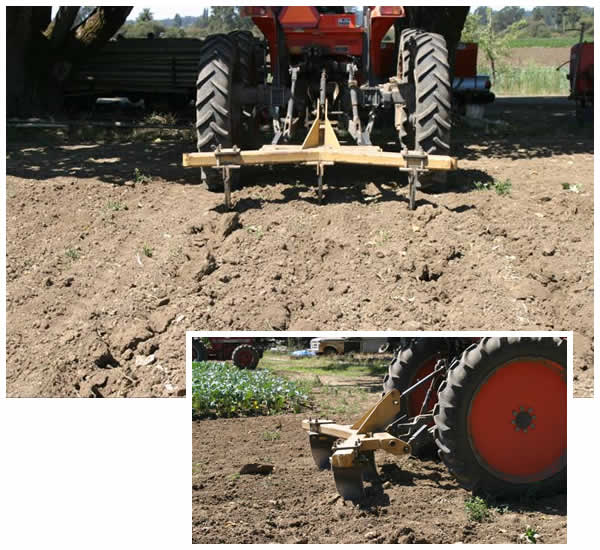
our new carrot field (not quite ready for harvest!)...
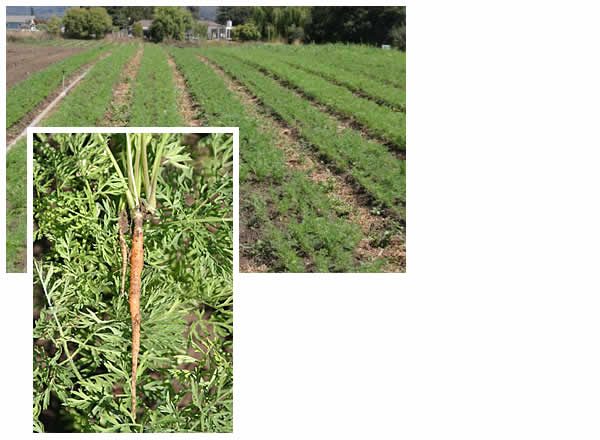
an Armenian or 'snake' cucumber, and the upcoming fields of Chinese cabbage
(background) and cauliflower
(foreground).
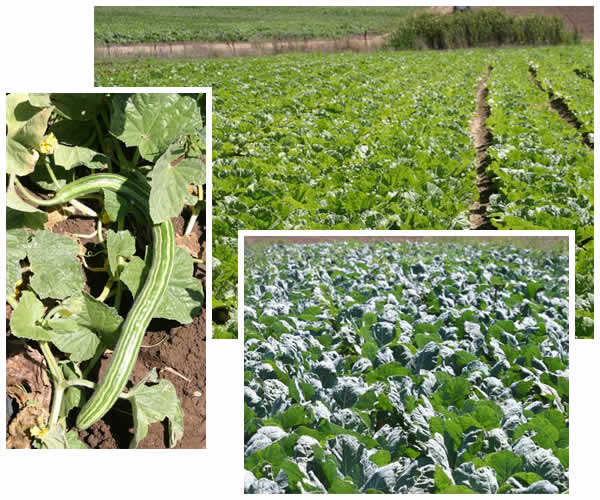
<back to top>
What's in the box this week
~~~~~~~~~~~~~~~~~~~~~~~~~~~~~~~~~~~~~~~~~~~~~~~~
Content differences between Family and Small
Shares are underlined and italicized; items with a “+” in
Family Shares are more in quantity than in Small; anticipated quantities are
in parentheses. Occasionally the content of your share will differ from what's
on this list, but we do our best to give you an accurate projection.
Family Share:
Basil
Broccoli
Armenian cucumber (see picture above!)
Daikon radish (Lakeside - picture below, in recipe section)
Eggplant (mix) +
Green beans
Lettuce (butter and/or romaine)
Sweet peppers (mix) +
Potatoes +
Cherry tomatoes
Dry-farmed tomatoes
Heirloom tomatoes
Strawberries (1 bskt)
Small Share:
Basil
Broccoli
Daikon radish (Lakeside - picture below, in recipe section)
Eggplant (mix)
Green beans
Lettuce (butter and/or romaine)
Sweet peppers (mix)
Potatoes
Cherry tomatoes
Dry-farmed tomatoes
Heirloom tomatoes
Strawberries (1 bskt)
Extra Fruit Option:
Strawberries (2 bskts), raspberries (1 bskt) and blackberries (1 bskt)
"Strawberry Bounty" Option:
-- stopped for now; will resume with next strawberry flush! --
<back to top>
Notes from Debbie's Kitchen
~~~~~~~~~~~~~~~~~~~~~~~~~~~~~~~~~~~~~~~~~~~~~~~~
Click
here to go to my extensive
recipe database, spanning 10 years of CSA recipes and alphabetized
by key ingredient. Includes photos of most farm veggies; helpful for
ID-ing things in your box!
Other than the daikon radish Tom’s putting in our shares from Lakeside
Organic Gardens (I’ll definitely give you some recipes for this), there’s
nothing new or surprising this week. So I’m going to skip over broccoli, green
beans, cucumbers and lettuce,
because there are plenty of ideas in the database for
these anyway. Plus by now I imagine you all are developing your own systems/routines/methods
for preparing and consuming your weekly bounty! That doesn’t mean you can’t
be inspired by new ideas though, so here are mine this week:
Anybody who’s read my stuff from prior seasons knows I’m nuts about
eggplant – I love it! So now that we’re
finally getting it I’m
excited to share the coolest idea I was given by someone I met at the CSA pre-conference
during Eco-Farm this past January. Yep, I’ve had to save it all this time,
waiting (im)patiently until we got eggplant again so I could spring it on you!
The concept is so simple and wonderful and cool – are you ready? Cook
your eggplant in a waffle iron. That’s it! Cut your eggplant into half-inch
thick slices, baste with olive oil, sprinkle with salt, then cook in a hot waffle
iron until softened inside and nicely browned inside the little waffle divots
on their surface. This takes only 3 to 4 minutes (I timed it). I found that when
I first put the slices on the waffle iron, it wouldn’t close all the way
(the slices towards the hinge side being firm at the outset), so I gently but
firmly squeezed the handles of the waffle iron together as the eggplant cooked
and softened. It took maybe a minute or so for the irons to close fully, then
I just let them cook until the ‘green light – waffles done’ indicator
came on. I set my waffle iron at ‘darker’ but use your own senses:
if the eggplant looks undercooked (yes you can peek!), let it go a little longer.
The flesh should be translucent. The best part about cooking eggplant this way
is all those wonderful little interstices for tomato sauce or cheese to sink
into! Come to think of it, I bet you could cook peppers in
the waffle iron too! Gonna have to try that next...
At the other end of the complexity spectrum here’s a totally fun and different
take on the Italian triad of basil, tomato and
ricotta that was in my most recent issue of Bon Appetit. I’d clipped it
out because it was so intriguing. It’s counter to my normal recipe ideas
for this newsletter in that it’s
rather long and involved, but it just sounded too cool to ignore, so I’ll
copy/paste the recipe here and you can make it if you like, or just have fun
reading about it, like I did. As usual, I’ll add my comments [square brackets] – you
know me, I can’t leave recipes alone!
Tomato, Basil and Ricotta Gelati
from Bon Appetit magazine, Sept 2007. Makes 6 servings
(Here's their photo too. It was too compelling not to include!)
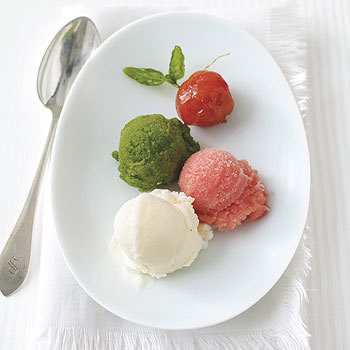
Tomato gelato ingredients:
2 lbs. medium-size deep-red ripe tomatoes (such as Early Girl) [perfect! that’s
what our dry-farmed tomatoes are!], halved, seeded, cored, coarsely chopped
1 C chilled Simple Syrup (recipe below)
Pinch of coarse kosher salt
Basil gelato ingredients:
1 1/2 C Simple Syrup
3 C fresh basil leaves (slightly packed; about 2 ounces)
6 tbsp. water
Ricotta gelato ingredients:
2 C fresh whole-milk ricotta cheese (about 16 ounces)
1/4 C whole milk
3/4 C chilled Simple Syrup
Garnish ingredients:
1 C sugar
1/3 C water
12 small cherry tomatoes [our Sungold cherries will do great here, and add another
color to the palette as well]
Vegetable oil (for frying)
12 fresh basil leaves
Tomato gelato preparation: Puree tomatoes in processor until smooth. Strain through
fine sieve, pressing on solids to release enough tomato puree to measure 2 cups.
Discard any remaining puree and solids in strainer. Add 1 cup chilled Simple
Syrup and pinch of coarse kosher salt to strained tomato puree; stir to blend.
Transfer tomato mixture to ice cream maker and process according to manufacturer's
instructions. Transfer gelato to container; cover and freeze until firm, about
3 hours. DO AHEAD: Can be made 2 days ahead. Keep frozen.
Basil gelato preparation: Bring 1 1/2 cups Simple Syrup to simmer in small saucepan.
Remove from heat; add 3 cups basil leaves to syrup and stir until wilted. Transfer
basil mixture to bowl and refrigerate until cold, about 2 hours. Puree basil
mixture and 6 tablespoons water in blender until smooth.
Transfer basil mixture to ice cream maker and process according to manufacturer's
instructions. Transfer gelato to container; cover and freeze until firm, about
3 hours. DO AHEAD: Can be made 2 days ahead. Keep frozen.
Ricotta gelato preparation: Combine ricotta cheese and milk in processor; puree
until smooth. Add 3/4 cup Simple Syrup and process until blended and smooth.
Transfer ricotta mixture to ice cream maker and process according to manufacturer's
instructions. Transfer gelato to container; cover and freeze until firm, about
3 hours. DO AHEAD: Can be made 2 days ahead. Keep frozen.
For garnish: Stir 1 cup sugar and 1/3 cup water in heavy small saucepan over
medium heat until sugar dissolves. Increase heat and boil without stirring until
color is medium amber (not deep amber), occasionally brushing down sides of pan
with pastry brush dipped in water and swirling pan, about 7 minutes. Remove pan
from heat. Gently drop tomatoes into hot caramel syrup, tilting pan to coat.
Using fork, quickly lift out tomatoes and transfer to sheet of foil. Cool tomatoes
completely. DO AHEAD: Candied cherry tomatoes can be made 5 hours ahead. Let
stand at room temperature.
Pour enough vegetable oil into heavy small saucepan to reach depth of 1 inch.
Attach deep-fry thermometer to side of saucepan. Heat oil over medium heat to
350°F. Add basil leaves and fry just until translucent, about 2 minutes.
Using slotted spoon, transfer basil to paper towels to drain. DO AHEAD: Can be
made 5 hours ahead. Let stand at room temperature.
Using 1- to 1 1/2-inch ice cream scoop, spoon out 1 scoop of each gelato into
shallow bowls or glasses. Garnish with candied cherry tomatoes and fried basil
leaves and serve.
Simple Syrup recipe
Makes about 4 cups
You'll use this mixture to sweeten all three gelati. But the syrup is also useful
for sweetening iced tea, fresh fruit drinks, and flavored cocktails.
3 C water
3 C sugar
Combine 3 cups water and 3 cups sugar in medium saucepan. Stir sugar and water
over medium heat until sugar dissolves. Increase the heat and bring to a boil.
Reduce heat to medium and simmer 3 minutes. Transfer syrup to bowl and chill
thoroughly. DO AHEAD: Syrup can be made 2 weeks ahead. Cover and keep refrigerated.
-----------------------
Here’s a recipe I’d saved from a cookbook simply called “Potatoes.” (Don’t
have any more credit to give than that; can’t remember when I made this
copy!) Anyway, I’ve edited it because I liked their idea but not their
technique, so they can’t complain! I know we don’t have onions in
our shares right now, but if you're like me, you probably all have them in your
fridge or pantry...
Roasted Balsamic Potatoes and Onions
Serves 4. This dish would go nicely with roasted meats and steak, with
a side of green beans or broccoli!
about 2 tbsp. olive oil
1¼ to 1½ lbs. of potatoes, larger potatoes cut into chunks
¾ lbs. onions, peeled, root ends intact [cut off the roots themselves,
just leave that core in that keeps the layers together], cut into wedges
¼ C balsamic vinegar
1 tbsp. fresh thyme or 1 tsp. dried
Salt and pepper
Preheat oven to 400 degrees F. Toss potatoes and onions in a bowl with olive
oil to coat evenly then spread out on a rimmed baking sheet, cover with foil
and roast 30 minutes. [Keep that bowl handy; we’ll be using it again!]
Remove foil, transfer partially cooked veggies back into bowl [careful when you
take off the foil – they’ll be hot!], then toss with vinegar and
thyme, plus salt and pepper to taste. Spread back out on same pan and roast,
uncovered, another 30 – 40 minutes, turning occasionally, until onions
are browned and potatoes are crisp on the edges.
-----------------------
Daikon radish
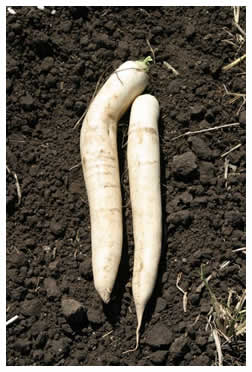 Tom says we can’t grow these ourselves because you need lots of sandy
soil, however Lakeside had a flush of them and the crop looked beautiful, so
he couldn’t
pass them up. So enjoy this new treat! I’ve never cooked or otherwise
used fresh daikon before, so I’m looking forward to it.
Tom says we can’t grow these ourselves because you need lots of sandy
soil, however Lakeside had a flush of them and the crop looked beautiful, so
he couldn’t
pass them up. So enjoy this new treat! I’ve never cooked or otherwise
used fresh daikon before, so I’m looking forward to it.
If you’ve ever eaten at a Japanese restaurant or sushi bar, that little
pile of white threads on your plate as a garnish/condiment is actually verrrrrryy
thinly slivered daikon. I watched a sushi chef once, and my eyes went wide as
he simply took a large very sharp knife and proceeded to create one long paper-thin
slice of radish by rotating the root lengthwise against his blade [daikon looks
like a giant white carrot], and then he rolled this back up and cut it
crosswise into threads – amazing! I don’t expect I’ll ever
be doing it that way [I’m sure he had decades of training], but a good
grater should do the trick for making something similar.
Daikon is very mild as radishes go. Here are some excerpts from ‘Farmer
John’s Cookbook: the real dirt on vegetables’ including a few recipes
further below.
“Most of us think of radishes as salad fixings, but in Japanese and Indian
cuisine daikon radishes are a common cooking vegetable. Besides adding crunch
and zip to a meal, daikon radishes are well known for their medicinal properties.
Macrobiotic and Ayurvedic traditions rate them highly as a health-promoting food.
Since they are milder in flavor than regular radishes, they can be used like
any other root vegetable in cooking.
“Storage and handling: wrap unwashed root [separate from greens if greens
are attached, but Tom says they’ll be without tops] in a plastic bag and
refrigerate for up to 2 weeks. There usually is no need to peel them. Wash in
cold running water to remove any lingering dirt, then slice, dice, chop or grate
according to whatever recipe you’re making. [Tom also mentioned that, since
the root is so big, you can just lop off pieces of it to use as needed, returning
the rest to your plastic bag in the fridge for later use.]
“Culinary uses:
<> make a colorful salad using a mixture of grated raw daikon, beets, carrots
and apples
<> serve daikon raw as a condiment with a heavy meal, as they are said
to aid digestion and cleanse the palate
<> Use daikon much as you would carrots or turnips in soups, stews and
stir-fries. They are a classic addition to miso soup.”
I loved this little quote from an Angelic Organics CSA member in the Farmer John
cookbook too: “When I was growing up in the Bay Area, my Uncle George used
to go out salmon fishing. Quite often during the season, he’d stop by unannounced
on his way home, and as soon as I saw his truck pull into the driveway, I’d
start grating the daikon root. We would drop our dinner plans and put the fish
right into the broiler. Gorgeous fresh salmon with lemon juice, soy sauce, grated
ginger, and loads of daikon. It was my favorite meal then, and still is now.”
Daikon in Plum Sauce
This fast and delightful recipe makes for a great introduction to the daikon.
It’s sweet and savory with a pleasing texture, and the daikon’s
distinct flavor shines through. – Angelic Organics Kitchen
Serves 3 to 4
3 tbsp. soy sauce
2 tbsp. rice vinegar
1 tsp. cornstarch
2 tbsp. plum sauce
1 tbsp. minced scallion
3 tbsp. peanut oil
1 daikon, peeled [didn’t they just get through saying above that you don’t
have to peel it?] and cut into matchstick-sized strips [or maybe coarsely grated
if matchsticking it seemed too tedious]
2 tbsp. water
Combine soy sauce, vinegar, and cornstarch in a small bowl; stir until cornstarch
dissolves. Stir in the plum sauce and scallions.
Heat the oil in a wok or large skillet over high heat. Swirl the oil around until
it covers the cooking area, then add the daikon; cook stirring constantly, for
30 seconds.
Add the water and cover. Cook until the daikon is tender, 1 to 2 minutes
Add the soy sauce mixture and continue cooking, stirring vigorously, until the
sauce has thickened, 2 to 3 minutes.
Daikon with Tahini Dressing
“This is an attention getting dish: it’s unique, it’s
attractive, and tastes wonderful. It goes well wherever you might see coleslaw.
It’s fantastic on a bed of lettuce served with fish, and it makes a great
light sandwich when stuffed into pita bread. Mix in some cooked shredded chicken
and an extra ¼ C tahini, and you have a delicious, unique chicken salad. – Angelic
Organics Kitchen (adapted from Recipes from a Kitchen Garden).
Serves 4
4 inches of daikon, cut into matchstick-sized sticks
¾ C thinly sliced red radishes [if you’re like me, you still have
some of these in your fridge from last week!]
1 medium carrot, grated (about ½ C)
¼ C tahini
4 scallions, thinly sliced
1½ tbsp. freshly squeezeds lemon juice (about half a lemon)
1 tbsp. dry sherry or vermouth
dash salt
[a little bit of] sugar
¼ C chopped almonds (optional)
Combine daikon, red radish, and carrots in a medium bowl.
Whisk the tahini, scallions, lemon juice, sherry, salt and sugar to taste in
a small bowl until well combined. Thin the dressing with a few tbsp. water until
the mixture is a smooth paste.
Toss the dressing with radishes until well combined. Garnish with almonds if
desired.
-----------------------
Lastly, here's a 'sweet' recipe sent me by member Farrell Podgorsek, who says,
"This is a great pie. It's a slightly modified version of a recipe from Cooks
Illustrated magazine." A little something for those strawberries, blackberries and
raspberries we're getting in the fruit shares!
Summer Berry Pie
Graham Cracker Crust:
9 graham crackers, processed into crumbs
5 tbsp. margarine or butter, melted
2 tbsp. sugar
Combine all ingredients. Transfer into a 9 inch glass pie plate. Press
into plate. Bake at 325 for 15 minutes. Cool.
Filling:
6 C farm berries - Blackberries, raspberries & strawberries -
rinsed
and patted dry with paper towels. Hull and quarter strawberries before
rinsing
1/2 C sugar
3 tbsp. cornstarch
pinch salt
1 tbsp. lemon juice
2 tbsp. jelly – currant, apricot or plum are all fine
Whisk sugar, cornstarch and salt in a bowl. Puree 2 1/3 cups of the berries in a food processor. Strain through a sieve to remove seeds. Transfer to a small saucepan. Add sugar mixture and bring to a boil over a medium heat, stirring constantly, until thickened to a pudding consistency. Remove from heat and add lemon juice. Cool slightly. Transfer remaining berries to a bowl. Heat jelly and pour over berries. Toss gently to coat. Pour slightly cooked puree into the crust. Top with the berries and press into puree. Refrigerate for 3 hours or more to set.
Calendar of Events
~~~~~~~~~~~~~~~~~~~~~~~~~~~~~~~~~~~~~~~~~~~~~~~~
(see calendar on website for more info)
<> Sat. Jun 23 Summer Solstice Celebration (click
here for a wonderful movie of this year's celebration!)
<>Friday Aug 10, 17, 24, 31, Sept 7 and 14 Mataganza
Garden Sanctuary Internship Program
<> Aug 24-26 Childrens Mini-Camp sold out!
<>
Sat. Oct 20 Fall Harvest Celebration
<back to top>
Contact Information
~~~~~~~~~~~~~~~~~~~~~~~~~~~
email Debbie at the farm: farmers@cruzio.com
email Debbie at home (with newsletter input or recipes): deb@writerguy.com
phone: 831.763.2448
web: http://www.liveearthfarm.net
~~~~~~~~~~~~~~~~~~~~~~~~~~~